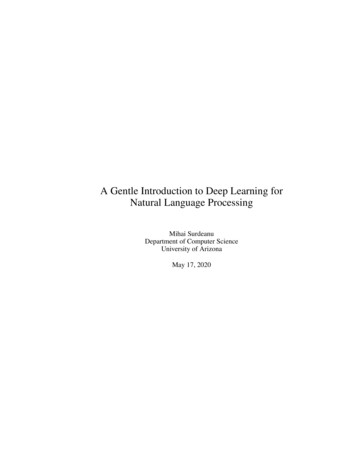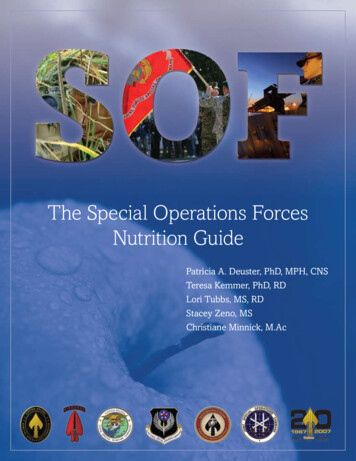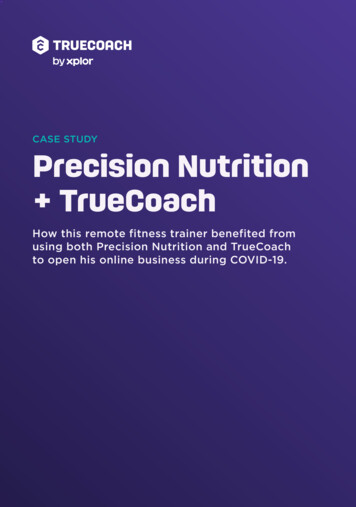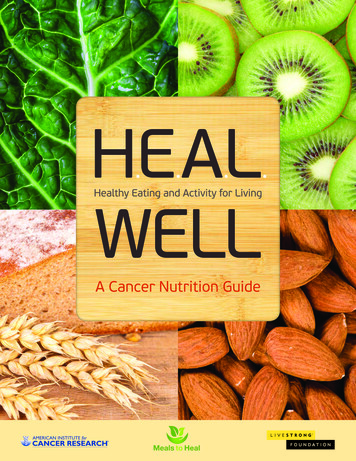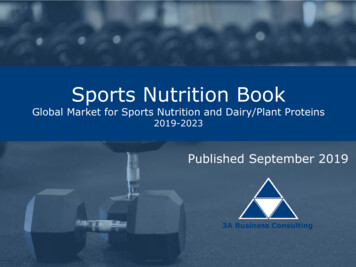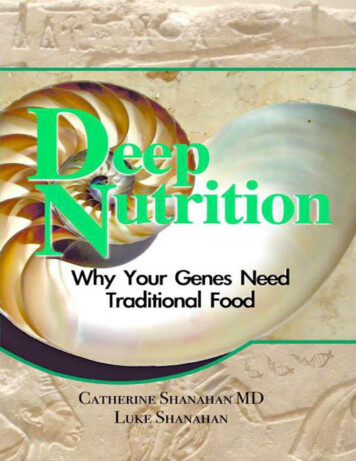
Transcription
Every effort has been made to ensure that the information contained in the book is complete andaccurate. However, neither the author nor the publisher is engaged in rendering advice to theindividual reader.Deep NutritionWhy Your Genes Need Traditional FoodCopyright 2009 by Catherine Shanahan, MD, Luke Shanahan, MFAAll rights reserved. No part of this publication may be reproduced or transmitted in any form, or byany means, without written consent of the author, except in the case of brief quotations embodied inreviews.Big BoxBooksLawai, HICover and Book Design: Catherine & Luke ShanahanNautilus Pompilus photo by Ethan HernAmarna Tablet clay replica by Luke ShanahanInterior cartoons by Catherine ShanahanLibrary of Congress Cataloging-in-Publication DataShanahan, Catherine MDDeep Nutrition: Why Your Genes Need Traditional FoodCatherine Shanahan, MD; Luke Shanahan, MFAIncludes bibliographical references and indexLibrary of Congress Control Number: 200890981To order, visit www.DrCate.comISBN-10: 0-615-22838-0ISBN-13 13:978-0-615-22838-9E-Book ISBN: 978-1-61397-266-3
Photo And Image CreditsNautilus Pompilus graphic, courtesy of John N. HarrisPersian girl, by Hamed Saber CC 3.0Clark Gable, from Gone With The Wind trailer, uncopyrightedTyson Beckford, by Jesse Gross CC 2.5Tom Cruise, by Alan Light CC 2.0Halle Berry, by Alexander Horn CC 2.5Blonde Student, by Yuri Arcurs Dick Cheney, Karen Ballard White House staffMarquardt Mask and overlays, Stephen Marquardt, Marquardt Beauty Analysis, courtesy of Dr.Marquardt, www.beautyanalysis.comCerebellum, photomicrograph courtesy of Jhodie DuncanIngrid Bergman, from Dr. Jekyll & Mr. Hyde trailer, uncopyrightedChristopher Reeve and Jane Seymour, from Somewhere In Time, publicity photoOprah Winfrey, by Alan Light CC 2.0Narrow Marquardt Mask, Stephen Marquardt, MDMaasai woman, Price Pottenger Nutrition Foundation, PPNF.orgMarquardt Mask, Stephen Marquardt, www.beautyanalysis.comThai woman, photo courtesy of David MillerGirl from Hamar tribe, photo courtesy of Terry BuxtonChildren milking goat, photo courtesy of Iman MP HeijboerKevin Dillon, photo courtesy of Allistair McMannisMatt Dillon, photo courtesy of Devin HydeNicky Hilton, by Eduardo Sciammarella, CC2.0Paris Hilton, by Paul Schäfermeier, CC2.5Prince William and Prince Harry, Getty ImagesThree Turlington sisters, by Sharon WohlmuthRalph Fiennes, promotional photoMartha, Magnus, Sophie, and Joseph Fiennes, Getty ImagesJacob Fiennes, Madam magazineFetal Alcohol Syndrome, photo by Teresa Kellerman, wwwlfasstar.comPetroglyph, by Andras Zboray, Fliegel Jerniczy Expeditions, gourd portion of petroglyph wasdigitally modified for better viewing in black and whiteTiger Woods, by Molly A Burgess, US Navy Petty Officer 2nd ClassMaasai Man, photo courtesy of John HanleyDean Ornish, by Pierre OmidyarSaccade tracings, by Alfred YarbusPetroglyph at Anasazi Ridge, courtesy of Don AustinKey
CC 2.0 Creative Commons Attribution 2.0 Generic /licenses/by-sa/2.5/ShareAlike2.5GenericCC 3.0 Creative Commons Attribution Unported http://creativecommons.org/licenses/by/3.0/
To BuddyOf all the souls we have met, he was the most human.
Special ThanksTo dozens of physicians at UCLA and UCSF for interviews and opinions. To Dr. Stephen Marquardtfor insights into his groundbreaking research. To Jo Robinson for her story of the discovery of omega3 fatty acids. To the Price-Pottenger Nutrition Foundation for making the extensive works of WestonA. Price and Dr. Francis Pottenger publicly available. To Yvette Bambas for questions fromhealthcare consumers. To George Brown for design. To my brother Dan Shanahan for cartoons. ToSandra Yue for countless hours of editing. To Jeff Tucker and Rob Kvidt of Techspokes.com forsocial media marketing. To Carol Pimental, Leona Soares, Lizelle Hernandez, and the staff of WestKauai Clinic Kalaheo for being so caring to my patients through the years. And to all the scientistsand researchers who still believe in the scientific method.
Table Of ContentsTitle PageCopyright PageIntroduction1. Reclaiming Your HealthThe Origins of Deep Nutrition2. The Intelligent GeneEpigenetics and the Language of DNA3. Dynamic SymmetryNature’s Desire for Beauty4. The Greatest GiftThe Creation and Preservation of Genetic Wealth5. A Mother’s WisdomLetting Your Body Create a Perfect Baby6. The Great Nutrition MigrationFrom the Culinary Garden of Eden to Outer Space7. The Four Pillars of World CuisineFoods that Program Your Body for Beauty, Brains, and Health8. Good Fats and BadHow the Cholesterol Theory Created a Sickness Epidemic9. Sickly SweetHow Carbohydrate-Rich Diets Block Metabolic Function10. Beyond CaloriesUsing Food as a Language to Achieve Ideal Body Weight11. Forever Young
Collagen Health and Life Span12. EpilogueHealth Without HealthcareAppendicesTests to Measure Your HealthSteps for Including The Four Pillars in Your DietOur Four Pillar MenuSelected RecipesShopping, Reading, and ResourcesReferences 307
IntroductionThis book describes the diet to end all diets.That’s easy to say, of course. All kinds of nutrition books claim to describe the one and only,best-of-all diet—the last one you’ll ever need. The truth is, there really are a lot of good diets outthere. You’re already familiar with some of them: the Okinawan, the Mediterranean, and the French—who “paradoxically” live long, healthy lives though their foods are so heavy and rich.As a physician, I’ve often wondered—as have many of my patients—what it is, exactly, thatmakes all these good diets so special. If the people in Japan, eating lots of fish and fresh vegetables,and the people of the Mediterranean, eating dairy and foods drenched in olive oil, can enjoy superiorhealth, and attribute their good health to the foods they eat, then how is it that—enjoying apparentlydifferent foods—they can both lay claim to the number one, best diet on Earth? Could it be that manycultures hold equal claim to a fantastically successful nutritional program? Might it be that people allover the world are doing things right, acquiring the nutrients their bodies need to stay healthy and feelyoung by eating what appear to be different foods but which are, in reality, nutritionally equivalent?This book comprehensively describes what could be called The Human Diet. It is the first toidentify and describe the commonalities between all the most successful nutritional programs peoplethe world over have depended on for millennia to protect their health and encourage the birth ofhealthy children so that the heritage of optimum health can be gifted to the next generation, and thegenerations that follow.We like to talk about leaving a sustainable, healthy environment for our children. The latestscience fuses the environmental discussion with the genetic one; when we talk environmentalsustainability, we are necessarily talking about our genomic sustainability.This is also the first book to discuss health across generations. Because of a new science calledepigenetics, it will no longer make sense to consider our health purely on the personal level. Whenwe think of our health, we think of our own bodies, as in “I feel good,” “I like my weight,” “I’m doingfine.” Epigenetics is teaching us that our genes can be healthy or sick, just like we can. And if ourgenes are healthy when we have children, that health is imparted to them. If our genes are ailing, thenthat illness can be inherited as well. Because epigenetics allows us to consider health in the contextof a longer timeline, we are now able to understand how what we eat as parents can changeeverything about our children, even the way they look. We’ll talk about how, with the right foods, wecan get our genome into shape to give our kids a fighting chance.One of the most important new concepts of Deep Nutrition is this idea that the foods parents eatcan change the way their children look. Actually, it’s not entirely new. Most of us are familiar withfetal alcohol syndrome, a developmental impairment characterized by a set of facial abnormalitiescaused by alcohol consumption during pregnancy. Those very same developmental impairments canbe caused by malnutrition. I see this every day in my clinic. You’ll learn why following the standard
dietary recommendations currently promoted by nutritionists and dietitians means running the risk thatyour child’s development will be similarly affected—something I call second sibling syndrome.There’s been a reluctance to equate good looks with good health—even, for that matter, tobroach the subject. But with the healthcare infrastructure creaking under the bloat of chronically illchildren and adults, it’s time to get real. We’re not talking about abstract aesthetic concepts of beauty.If you’re planning on having a child, and you want them to have every opportunity in life, you wantthem to be physically attractive. How do we know what’s attractive? We met with the world’s leadingexpert in the science of beauty to find out for ourselves what exactly makes a person pretty or plain.His name is Dr. Stephen Marquardt. He’s a highly sought-after plastic surgeon living outside LA, andhis “Marquardt Mask” shows how the perfect human face is the inevitable result of a person’s bodygrowing in accordance with the mathematical rules of nature.You’re going to meet another maverick, a man who should be considered the father of modernnutrition. Like Marquardt, the plastic surgeon, this modest dentist refused to accept the idea that itwas natural for children’s teeth to crowd and shift as haphazardly as tombstones on frost-heavedground. Teeth should fit, he insisted. He traveled the world to determine if remaining on traditionalfoods would ensure the proper growth of children so that their teeth, their eyes, and every organ intheir body would match one another in perfect proportion, ensuring optimum function andextraordinary health. He discovered that human health depends on traditional foods. Epigeneticsproves that this is so because our genes expect the nutrients traditional foods provide.When you have finished reading this book, you will have completely revised the way you thinkabout food. We’re going to do away with calorie counting and struggling to find the perfect ratio ofcarbs to protein to fat. These terms aren’t useful because they say nothing about what really mattersabout your food. Food is like a language, an unbroken information stream that connects every cell inyour body to an aspect of the natural world. The better the source and the more undamaged themessage when it arrives to your cells, the better your health will be. If you eat a properly cookedsteak from an open-range, grass-fed cow, then you are receiving information not only about the healthof that cow’s body, but about the health of the grasses from which it ate, and the soil from which thosegrasses grew. If you want to know whether or not a steak, or a fish, or a carrot is good for you, askyourself what portions of the natural world it represents, and whether or not the bulk of thatinformation remains intact. This requires traveling backwards down the food chain, step by step, untilyou reach the ground or the sea.In the following chapters, you will learn that the secret to health—the big secret, the one noone’s talking about—is that there is no secret. Getting healthy, really healthy, and staying healthy canbe easy. Avoiding cancer and dependence on medications, staving off heart disease, keeping a razorsharp mind well into advanced years, and even having healthy, beautiful children are all aspects ofthe human experience that can be, and should be, under your control. You can live better, and itdoesn’t have to be that difficult. You just have to be armed with the right information.No matter what you already believe about diet, medicine, or health—including the limits of yourown health—the book you’re about to read will enable you to make better sense of what you alreadyknow. To answer what is for many people a nagging question: Who’s right? What’s the simple,complete picture that ties all the best information together, so that I can know, once and for all, whichfoods my family is supposed to eat and which ones we need to avoid? How can I be sure that whatI’m preparing for my children will give them a better chance to grow normally, succeed in school,and live long, happy lives?What am I supposed to make for dinner?
This book will give you the answer.
OneReclaiming Your HealthThe Origins of Deep NutritionAsk ten people what the healthiest diet in the world is and you’ll get ten different answers. Somepeople swear by the Okinawa diet. Others like the Mediterranean or the French. But have you everthought to wonder what it is about all these traditional diets that makes the people eating them sohealthy? This book will describe the common rules that link all successful diets. We call them theFour Pillars of World Cuisine. Throughout history, people have used them to protect their own health,and grow healthy, beautiful children.In other words, they used diet to engineer their bodies. Most of us probably have somethingwe’d want to change about the way we look, or about our health. What if you could use food tochange your body at the genetic level?Think about it: What if you could re-engineer your genes to your liking? Want to be like Mike?How about Tiger Woods? Halle Berry? George Clooney? Or maybe you want to change your genes sothat you can still be you, only better. Just a modest upgrade—a sexier body, better health, greaterathleticism, and a better attitude. When you start to consider what you might be willing to pay for allthis, you realize that the greatest gift on Earth is a set of healthy genes. The lucky few who do inheritpristinely healthy genes are recognized as “genetic lottery winners” and spend their lives enjoying themany benefits of beauty, brains, and brawn. Being a genetic marvel doesn’t mean you automaticallyget everything you want. But if you have the genes and the desire, you can have the world at your feet.Back in the mid 1980s, a handful of biotech millionaires thought they had the technology to bringdaydreams like these to life. They organized the Human Genome Project, which, we were told, wasgoing to revolutionize how medicine was practiced and how babies were conceived and born.At the time, conventional medical wisdom held that some of us turn out beautiful and talentedwhile others don’t because, at some point, Mother Nature made a mistake or two while reproducingDNA. These mistakes lead to random mutations and, obviously, you can’t be a genetic marvel if yourgenes are scabbed with mutations. The biotech wiz kids got the idea that if they could get into ourgenes and fix the mutations—with genetic vaccines or patches—they could effectively rig the lottery.On June 26, 2000, they reached the first milestone in this ambitious scheme and announced they’dcracked the code.“This is the outstanding achievement not only of our lifetime but in terms of human history,” Dr.Michael Dexter, the project’s administrator, declared.1 Many were counting on new technology suchas this to magically address disease at its source. Investors and geneticists promised the mutationsresponsible for hypertension, depression, cancer, male pattern baldness—potentially whatever wewanted—would soon be neutralized and corrected. In the weeks that followed, I listened to scientistson talk shows stirring up publicity by claiming the next big thing would be made-to-order babies,fashioned using so-called designer genes. But I was skeptical. Actually, more than skeptical—I knewit to be hype. I knew this because a decade earlier, in 1989, while at Cornell University, I learned
from leaders in the field that a layer of biologic complexity existed which would undermine suchbullish predictions. It was an inconvenient reality these scientists kept tucked under their hats.While the project’s supporters described our chromosomes as static chunks of information thatcould be easily (and safely) manipulated, a new field of science, called epigenetics, had alreadyproved this fundamental assumption wrong. Epigenetics helps us understand that the genome is morelike a dynamic, living being—growing, learning, and adapting constantly. You may have heard thatmost disease is due to random mutations, or “bad” genes. But epigenetics tells us otherwise. If youneed glasses or get cancer or age faster than you should, you very well may have perfectly normalgenes. What’s gone wrong is how they function, what scientists call genetic expression. Just as wecan get sick when we don’t take care of ourselves, it turns out, so can our genes.Your Diet Changes How Your Genes WorkIn the old model of genetic medicine, diseases arise from permanent damage to DNA, calledmutations, portions of the genetic code where crucial data has been distorted by a biological typo.Mutations were thought to arise from mistakes DNA makes while generating copies of itself, andtherefore, the health of your genes (and Darwinian evolution) was dependent on random rolling of thedice. Mutations were, for many decades, presumed to be the root cause of everything from knockknees to short stature to high blood pressure and depression. This model of inheritance is the reasondoctors tell people with family histories of cancer, diabetes, and so on that they’ve inherited genetictime bombs ready to go off at any moment. It’s also the reason we call the genetic lottery a lottery.The underlying principle is that we have little or no control. But epigenetics has identified a ghost inthe machine, giving us a different vision of Mother Nature’s most fantastic molecule.Epigenetic translates to upon the gene. Epigenetic researchers study how our own genes reactto our behavior, and they’ve found that just about everything we eat, think, breathe, or do can, directlyor indirectly, trickle down to touch the gene and affect its performance in some way. These effects are
carried forward into the next generation where they can be magnified. In laboratory experimentsresearchers have shown that, simply by feeding mice with different blends of vitamins, they canchange the next generation’s adult weight and susceptibility to disease, and these new developmentscan then be passed on again, to grandchildren.2 It’s looking as though we’ve grossly underestimatedthe dictum You are what you eat. Not only does what we eat affect us down to the level of our genes,our physiques have been sculpted, in part, by the foods our parents and grandparents ate (or didn’teat) generations ago.The body of evidence compiled by thousands of epigenetic researchers working all over theworld suggests that the majority of people’s medical problems do not come from mutations, aspreviously thought, but rather from harmful environmental factors that force good genes to behavebadly, by switching them on and off at the wrong time. And so, genes that were once healthy can, atany point in our lives, start acting sick.The environmental factors controlling how well our genes are working will vary from minute tominute, and each one of your cells reacts differently. So you can imagine how complex the system is.It’s this complexity which makes it impossible to predict whether a given smoker will develop lungcancer, colon cancer, or no cancer at all. The epigenetic modulation is so elaborate and so dynamicthat it’s unlikely we’ll ever develop a technologic fix for most of what ails us. So far, it may soundlike epigenetics is all bad news. But ultimately, epigenetics is showing us that the genetic lottery isanything but random. Though some details may forever elude science, the bottom line is clear: Wecontrol the health of our genes.The concept of gene health is simple. Genes work fine until disturbed. External forces thatdisturb the normal ebb and flow of genetic function can be broken into two broad categories: toxinsand nutrient imbalances. Toxins are harmful compounds we may eat, drink, or breathe into our bodies,or even manufacture internally when we experience undue stress. Nutrient imbalances are usually dueto deficiencies, missing vitamins, minerals, fatty acids, or other raw materials required to run ourcells. You may not have control over the quality of the air you breathe or be able to quit your job inorder to reduce stress. But you do have control over what may be the most powerful class of generegulating factors: food.A Holistic Perspective of FoodBelieve it or not, designer babies aren’t a new idea. People “designed” babies in ancient times.No, they didn’t aim for a particular eye or hair color; their goal was more practical—to give birth tohealthy, bright, and happy babies. Their tools were not high technology in the typical sense of theword, of course. Their tool was biology, combined with their own common sense wisdom and carefulobservation. Reproduction was not entered into casually, as it too often is today, because theproduction of healthy babies was necessary to the community’s long-term survival. Through trial anderror people learned that, when certain foods were missing from a couple’s diet, their children cameout with problems. They learned which foods helped to ease delivery, which encouraged theproduction of calmer, more intelligent children who grew rapidly and rarely fell sick, and then passedthis information on. Without this nurturing wisdom, we—as we are presently defined—never wouldhave made it this far.Widely scattered evidence indicates that all successful cultures accumulated vast collections ofnutritional guidelines anthologized over the course of many generations and placed into a growingbody of wisdom. This library of knowledge was not a tertiary aspect of these cultures. It was
ensconced safely within the vaults of religious doctrine and ceremony to ensure its unending revival.The following excerpt offers one example of what the locals living in Yukon Territory (in Canada)knew about scurvy, a disease of vitamin C deficiency, which at the time (in 1930), still killedEuropean explorers to the region:When I asked an old Indian [ ]why he did not tell the white man how [to prevent scurvy],his reply was that the white man knew too much to ask the Indian anything. I then asked him ifhe would tell me. He said he would if the chief said he might. He returned in an hour, sayingthat the chief said he could tell me because I was a friend of the Indians .He then describedhow when the Indian kills a moose he opens it up and at the back of the moose just above thekidney there are what he described as two small balls in the fat [the adrenal glands]. Thesehe said the Indian would take and cut up into as many pieces as there were little and bigIndians in the family and each one would eat his piece.3When I first encountered this passage, it was immediately obvious just how sophisticated theaccumulated knowledge once was—far better than my medical school training in nutrition. Mytextbooks said that vitamin C only comes from fruits and vegetables. In the text, the chief makesspecific reference to his appreciation of the interviewer’s advice to avoid the food in the tradingposts, demonstrating how, in indigenous culture, advice regarding food and nutrition is held in highesteem, even treated as a valuable object that can serve as consideration in a formal exchange. We’vebecome accustomed to using the word “share” these days, as in, Let me share a story with you. Butthis was sharing in the truest sense, as in offering a gift of novel weaponry or a fire-starting device—items not to be given up lightly. In fact, the book’s author admitted consistent difficulty extractingnutrition-related information for this very reason. There is an old African saying, When an elder dies,a library burns to the ground. And so, unfortunately, this particular human instinct—anunderstandable apprehension of sharing with outsiders—has allowed much of what used to be knownto die away.Today we are raised to think of food as a kind of enriched fuel, a source of calories and a carrierfor vitamins, which help prevent disease. In contrast, ancient peoples understood food to be a holything, and eating was a sanctified act. Their songs and prayers reflected the belief that, in consumingfood, each of us comes in contact with the great, interconnected web of life. Epigentics proves thatintuitive idea to be essentially true. Our genes make their day-to-day decisions based on chemicalinformation they receive from the food we eat, information encoded in our food and carried from thatfood item’s original source, a microenvironment of land or sea. In that sense, food is less like a fueland more like a language conveying information from the outside world. That information programsyour genes, for better or for worse. Today’s genetic lottery winners are those people who inheritedwellprogrammed, healthy genes by virtue of their ancestor’s abilities to properly plug into thatchemical information stream. If you want to help your genes get healthy, you need to plug in too—andthis is the book that can help.For ten years, I have studied how food programs genes and how that programming affectsphysiology. I’ve learned that food can tame unruly genetic behavior far more reliably thanbiotechnolgy. By simply replenishing your body with the nourishment that facilitates optimal geneexpression, it’s possible to eliminate genetic malfunction and, with it, pretty much all known disease.No matter what kind of genes you were born with, I know that eating right can help reprogram them,immunizing you against cancer, premature aging and dementia, enabling you to control your
metabolism, your moods, your weight—and much, much more. And if you start planning early enough,and your genetic momentum is strong enough, you can give your children a shot at reaching for thestars.Who Am I?In many ways, it was my own unhealthy genes that inspired me to go to medical school and,later, to write this book. I’d had more than my fair share of problems from the beginning of my sportscareer. In high school track, I suffered with Achilles tendonitis, then calcaneal bursitis, then iliotibialband syndrome, and it seemed to me that I was constantly fitting corrective inserts into my shoes oradding new therapeutic exercises to my routine. In college I developed a whole new crop of softtissue problems, including a case of shin splints so severe it almost cost me my athletic scholarship.When my shin splints got bad enough that I had to start skipping practice, I paid another visit tothe team physician. Dr. Scotty, a stubby, mustached man with thick black hair and a high-pitchedvoice, told me that this time he couldn’t help me. All I could do was cut back my training and wait.But I was sure there was something else I needed to do. Perhaps I had some kind of dietarydeficiency? Applying my newly acquired mastery of biology 101, I suggested that, perhaps, myconnective tissue cells couldn’t make normal tendons. Like many of my own patients insist today, Ipushed Dr. Scotty to get to the bottom of my problem. I even had a plan, simply take some kind ofbiopsy of the tendon in my leg and compare the material to a healthy tendon. My ideas went nowhere,as I imagine such suggestions often do. Dr. Scotty furrowed his bushy eyebrows and said he’d neverheard of any such test. I’d read stories in Newsweek and Time about the powerful diagnostics beingbrought to us by molecular biology. In my naiveté, I couldn’t believe Dr. Scotty didn’t know how useany of that science to help me. I was so confounded by the unwillingness to consider what seemed tome to be the obvious course of action, and so enamored with the idea of getting to the molecular rootof physical problems—and so enthralled by the promise of the whole burgeoning biotech field—that Iscrapped my plans to be a chemical engineer and enrolled in every course I could to study genetics. Iwent to graduate school at Cornell, where I learned about gene regulation and epigenetics from Nobelprizewinning researchers, then straight to Robert Wood Johnson Medical School in New Jersey, inhopes of putting my knowledge of the fundamentals of genetics to practical use.I then found out why Dr. Scotty had been dumfounded by my questions years before. Medicalschool doesn’t teach doctors to address the root of the problem. It teaches doctors to treat theproblem. It’s a practical science with practical aims. In this way, medicine differs quite drasticallyfrom other natural sciences. Take, for instance, physics, which has built a body of deep knowledge byalways digging down to get to the roots of a problem. Physicists have now dug so deep that they aregrappling with one of the most fundamental questions of all: How did the universe begin? Butmedicine is different from other sciences because, more than being a science, it is first and foremost abusiness. This is why, when people taking a heart pill called Loniten started growing unwanted hairon their arms, researchers didn’t ask why. Instead, they looked for customers. And Loniten the heartpill became Rogaine, the spray for balding men. Medicine is full of examples like this, one the mostlucrative being the discovery of Sildafenil, originally for blood pressure until found to have the happyside effect of prolonging erections and repackaged into Viagra. Since medicine is a business, medicalresearch must ultimately generate some kind of saleable product. And that is why we still don’t knowwhat leads to common problems like shin splints.I didn’t go to medical school to become a businesswoman. My dreams had sprouted from a seed
planted in my psyche when I was five, during an incident with a baby robin. Sitting on the street curbin front of my house one spring morning, the plump little fledgling flew down from the maple tree toland on the street in f
In the following chapters, you will learn that the secret to health—the big secret, the one no one’s talking about—is that there is no secret. Getting healthy, really healthy, and staying healthy can be easy. Avo





